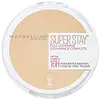Maybelline Super Stay Full Coverage Powder Foundation Versus Maybelline Dream Matte Mousse Foundation
What's inside
What's inside
 Key Ingredients
Key Ingredients

 Benefits
Benefits

 Concerns
Concerns

 Ingredients Side-by-side
Ingredients Side-by-side

Talc
AbrasiveMagnesium Stearate
Cosmetic ColorantPolymethyl Methacrylate
Synthetic Fluorphlogopite
Isononyl Isononanoate
EmollientNylon-12
Hydrogenated Polydecene
EmollientVinyl Dimethicone/Methicone Silsesquioxane Crosspolymer
Diphenyl Dimethicone/Vinyl Diphenyl Dimethicone/Silsesquioxane Crosspolymer
Aluminum Hydroxide
EmollientDimethicone
EmollientPerfluorooctyl Triethoxysilane
Ethylhexylglycerin
Skin ConditioningLauroyl Lysine
Skin ConditioningMethicone
EmollientHydrogenated Palm Oil
EmollientPalmitoyl Proline
Skin ConditioningGlycerin
HumectantHydrogen Dimethicone
Water
Skin ConditioningSodium Palmitoyl Sarcosinate
CleansingMagnesium Palmitoyl Glutamate
Skin ConditioningPalmitic Acid
EmollientPhenoxyethanol
PreservativeMoringa Oleifera Seed Extract
Skin ConditioningDisodium Phosphate
BufferingCitric Acid
BufferingTocopherol
AntioxidantCI 77891
Cosmetic ColorantMica
Cosmetic ColorantCI 77491
Cosmetic ColorantCI 77492
Cosmetic ColorantCI 77499
Cosmetic ColorantTalc, Magnesium Stearate, Polymethyl Methacrylate, Synthetic Fluorphlogopite, Isononyl Isononanoate, Nylon-12, Hydrogenated Polydecene, Vinyl Dimethicone/Methicone Silsesquioxane Crosspolymer, Diphenyl Dimethicone/Vinyl Diphenyl Dimethicone/Silsesquioxane Crosspolymer, Aluminum Hydroxide, Dimethicone, Perfluorooctyl Triethoxysilane, Ethylhexylglycerin, Lauroyl Lysine, Methicone, Hydrogenated Palm Oil, Palmitoyl Proline, Glycerin, Hydrogen Dimethicone, Water, Sodium Palmitoyl Sarcosinate, Magnesium Palmitoyl Glutamate, Palmitic Acid, Phenoxyethanol, Moringa Oleifera Seed Extract, Disodium Phosphate, Citric Acid, Tocopherol, CI 77891, Mica, CI 77491, CI 77492, CI 77499
Cyclopentasiloxane
EmollientDimethicone
EmollientSqualane
EmollientDimethicone Crosspolymer
Emulsion StabilisingDimethicone/Vinyl Dimethicone Crosspolymer
Skin ConditioningHydrogenated Jojoba Oil
AbrasivePolymethylsilsesquioxane
Methyl Methacrylate Crosspolymer
Silica Dimethyl Silylate
EmollientPhenoxyethanol
PreservativePhenyl Trimethicone
Skin ConditioningDisodium Stearoyl Glutamate
CleansingVinyl Dimethicone/Methicone Silsesquioxane Crosspolymer
Methylparaben
PreservativeAluminum Hydroxide
EmollientBHT
AntioxidantButylparaben
MaskingEthylparaben
PreservativePropylparaben
PreservativeCI 77891
Cosmetic ColorantCI 77491
Cosmetic ColorantCI 77492
Cosmetic ColorantCI 77499
Cosmetic ColorantCI 77163
Cosmetic ColorantFish Oil
Skin ConditioningCyclopentasiloxane, Dimethicone, Squalane, Dimethicone Crosspolymer, Dimethicone/Vinyl Dimethicone Crosspolymer, Hydrogenated Jojoba Oil, Polymethylsilsesquioxane, Methyl Methacrylate Crosspolymer, Silica Dimethyl Silylate, Phenoxyethanol, Phenyl Trimethicone, Disodium Stearoyl Glutamate, Vinyl Dimethicone/Methicone Silsesquioxane Crosspolymer, Methylparaben, Aluminum Hydroxide, BHT, Butylparaben, Ethylparaben, Propylparaben, CI 77891, CI 77491, CI 77492, CI 77499, CI 77163, Fish Oil
 Reviews
Reviews

Ingredients Explained
These ingredients are found in both products.
Ingredients higher up in an ingredient list are typically present in a larger amount.
Aluminum Hydroxide is a form of aluminum. It can be naturally found in nature as the mineral gibbsite. In cosmetics, Aluminum Hydroxide is used as a colorant, pH adjuster, and absorbent.
As a colorant, Aluminum Hydroxide may add opacity, or reduce the transparency. Aluminum hydroxide is contains both basic and acidic properties.
According to manufacturers, this ingredient is an emollient and humectant. This means it helps hydrate the skin.
In medicine, this ingredient is used to help relieve heartburn and help heal ulcers.
There is currently no credible scientific evidence linking aluminum hydroxide in cosmetics to increased cancer risk.
Major health organizations allow the use of aluminum hydroxide in personal care products and have not flagged it as a carcinogenic risk at typical usage levels.
Learn more about Aluminum HydroxideCi 77491 is also hydrated iron III oxide. It's sole purpose is to give a red/pink hue to products.
Iron III oxides are classified as inorganic chemicals for coloring.
Synthetically created Ci 77491 is considered safer than those naturally found. This is because the synthetically created version may contain less impurities. Iron oxides are generally non-toxic and non-allergenic.
Learn more about CI 77491Ci 77492 is also hydrated iron III oxide. It's sole purpose is to give a yellow hue to products.
Iron III oxides are classified as inorganic chemicals for coloring.
Synthetically created Ci 77492 is considered safer than those naturally found. This is because the synthetically created version may contain less impurities. Iron oxides are generally non-toxic and non-allergenic.
Learn more about CI 77492Ci 77499 is also hydrated iron III oxide. It is created from mixing red and black iron oxides. This helps give shades of darkness to a product.
Iron III oxides are classified as inorganic chemicals for coloring.
Ci 77891 is a white pigment from Titanium dioxide. It is naturally found in minerals such as rutile and ilmenite.
It's main function is to add a white color to cosmetics. It can also be mixed with other colors to create different shades.
Ci 77891 is commonly found in sunscreens due to its ability to block UV rays.
Learn more about CI 77891Dimethicone is a type of synthetic silicone created from natural materials such as quartz.
What it does:
Dimethicone comes in different viscosities:
Depending on the viscosity, dimethicone has different properties.
Ingredients lists don't always show which type is used, so we recommend reaching out to the brand if you have questions about the viscosity.
This ingredient is unlikely to cause irritation because it does not get absorbed into skin. However, people with silicone allergies should be careful about using this ingredient.
Note: Dimethicone may contribute to pilling. This is because it is not oil or water soluble, so pilling may occur when layered with products. When mixed with heavy oils in a formula, the outcome is also quite greasy.
Learn more about DimethiconePhenoxyethanol is a preservative that has germicide, antimicrobial, and aromatic properties. Studies show that phenoxyethanol can prevent microbial growth. By itself, it has a scent that is similar to that of a rose.
It's often used in formulations along with Caprylyl Glycol to preserve the shelf life of products.
This ingredient is used in makeup and skincare to thicken formulas, reduce shine, and give skin a silky-smooth feel.
It’s a white silicone powder that sits in fine lines and pores to blur their appearance though its effectiveness depends on the particle size.
You'll typically find this ingredient in amounts between 0.1-20%.
Learn more about Vinyl Dimethicone/Methicone Silsesquioxane Crosspolymer